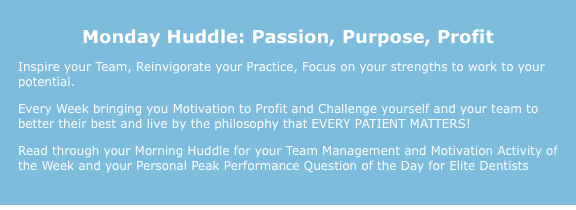I was encouraged by the feedback and report from the trenches of so many practices going to work on their seamless patient flow and cycle of communication. You must take the sacred rule of never having a gap in the patient experience very serious.
This, of course, is not just about when the patients are in your office, that’s easy, they are in front of your face, but it is also important before they come in and especially when they leave.
There are often gaps when general patients are referred out for various specialty procedures and then the patients are lost in the shuffle, in sending out for sleep tests, or even coming back in for a treatment conference. This is a big one: when a patient is agreeing to the first phase of treatment understanding that the next phase will be discussed and scheduled upon completion of the first but there is no consistency of communication, no proper preparation or strategy from one team member to the next. No one is paying attention to the fact that this is more than just “unscheduled treatment” it is accepted treatment assumed to be moved forward on by the patient but the patient isn’t going to bring it up themselves.
More treatment than you realize is “accepted” but never fully and firmly closed, scheduled and collected on. However, it could be firmed up at the very next visit if there is proper communication flow, your handoffs go beyond the four walls of the practice and you follow the patient forward through the completion of the treatment plan which should be EVERYONE’S STANDARD OF CARE.
Complete the treatment.
So simple. So important. So easy to miss, let fall through the cracks or get lost along the way.
Now, the second secret to the perfect and most effective handoffs. This is about tactics. About the choreography and commitment to not half-attempting the handoffs.
Remember the old adage we learned in school…
Tell them what you are going to tell them,
Tell them,
Tell them what you told them.
This is a great reminder of how to handle communication with your patients and how to execute on the best handoffs possible.
You want to focus on three things:
Patient’s goals
Patient’s problems
Patient’s clinical yes (and/or next steps depending on where they are at in the process and experience)
To every team member you will pass off the patient by: restating the point of the visit, why the patient is here and what is important to them. Then you will bluntly and vividly (whenever possible with actual photographs), convey the severity of the patient’s problem and reality of the current state of the patient’s mouth. Then you are going to connect the two together with the third piece of information by explaining what is going to be done to remove the problems and accomplish the goals.
Why this matters is because (if you are following along with my Friday Weekly Reports), you know this ties directly into trust and transparency of providing explanation and expectation to the patient by way of talking to your team member. That way you can say things to them that you may or may not say directly to the patient but the patient is right there (ALWAYS) listening and hearing what you are saying. This allows you to voice inflect, be more dramatic, express time sensitivity and enforce the smart decision the patient is making.
The tactics of every handoff should always include ALL the information necessary for the next team member to carry on with the rest of the objectives of the next steps in the visit and they should not need to ask any questions or go searching for anything on their own.
Every handoff should stand alone. That is the test. If it does (and you do not have any gaps), then you will have built a very complete system with a flow of communication that the patient participates in. In addition, the patient is being influenced every step of the way with a politely assumptive dialogue that you, your team members and doctor are controlling.
Digest this. Discuss this. Practice this. Rate yourselves on how consistent you are and pick apart where you can improve. Take the constructive criticism and work to make everyone congruent with each handoff every time for every patient through every step.
It takes everyone to make it the most successful possible and it takes just one to break the chain, sabotage the flow and lose the patients engagement along the way.
Next week, we’ll go through some specific examples. Feel free to send me some of your own challenging circumstances you might want me to elaborate on right here.



